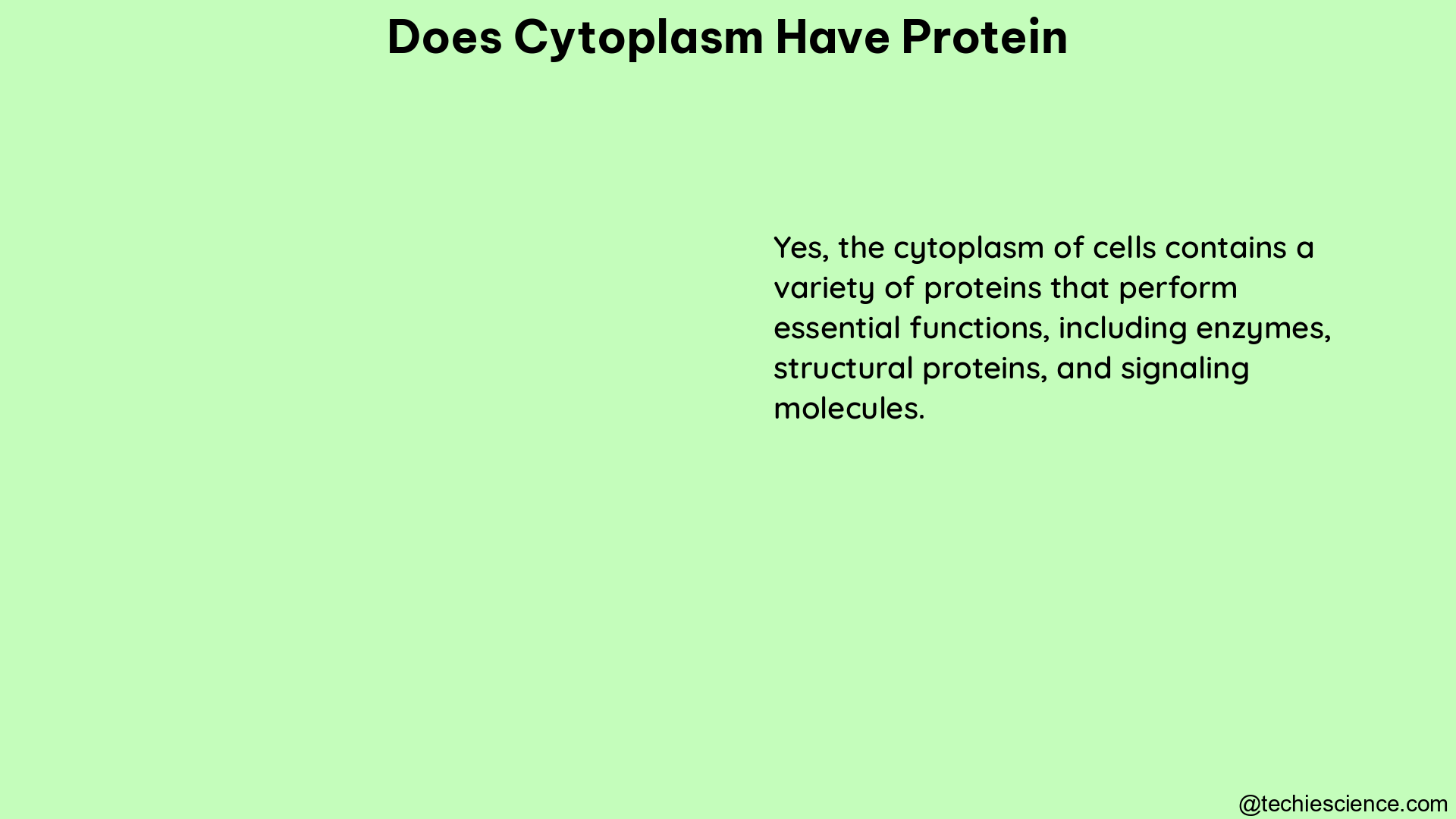The cytoplasm, the material inside a cell excluding the nucleus, is a complex and dynamic environment that plays a crucial role in cellular function. At the heart of this cytoplasmic landscape lies a diverse array of proteins, which contribute to a wide range of cellular processes. Understanding the presence and role of proteins within the cytoplasm is essential for comprehending the intricate workings of the cell.
Protein Abundance in the Cytoplasm
Quantitative studies have provided valuable insights into the abundance of proteins in the cytoplasm. According to a study, the average mammalian cell is estimated to contain around 200 million protein molecules, with an average of 4,000 different protein species present. This remarkable diversity of proteins highlights the cytoplasm’s role as a hub of cellular activity.
The concentration of proteins in the cytoplasm is also noteworthy, with estimates ranging from 200 to 400 milligrams per milliliter (mg/mL). This protein concentration is comparable to the protein content found in milk, underscoring the cytoplasm’s dense and protein-rich nature.
Protein Stability and Cellular Functions

The stability of proteins within the cytoplasm is closely linked to their cellular functions. A study analyzing gene expression in the cytoplasm revealed that the mRNAs and proteins of abundantly expressed housekeeping genes, which maintain normal cellular functions, are generally stable. This energy-saving strategy allows cells to conserve valuable resources, as protein production is a resource-intensive process.
In contrast, proteins involved in rapid signaling processes tend to be less stable, enabling cells to quickly adapt to changes in their environment. This dynamic balance between stable and unstable proteins ensures the cytoplasm’s ability to respond to various stimuli and maintain cellular homeostasis.
Protein Diffusion and Mesoscopic Modeling
The movement and diffusion of proteins within the cytoplasm have been the subject of extensive research. Mesoscopic modeling techniques, which involve constructing a three-dimensional digital model of the cell from confocal microscopy data, have provided valuable insights into protein diffusion.
These models account for the effective, position-dependent porosity of the cell, allowing for the distinction between diffusion in the liquid phase (cytosol/nucleosol) and the more complex cytoplasm/nucleoplasm. By using fully numerical mesoscopic methods, researchers can gain a deeper understanding of how proteins navigate the intricate cytoplasmic environment.
Cytoplasmic Protein Roles and Functions
The proteins present in the cytoplasm are responsible for a diverse array of cellular functions, including:
-
Structural Support: Cytoskeletal proteins, such as actin and tubulin, provide structural support and shape to the cell, enabling it to maintain its integrity and undergo dynamic changes.
-
Enzymatic Activity: Numerous enzymes within the cytoplasm catalyze a wide range of chemical reactions, facilitating essential metabolic processes and energy production.
-
Signaling and Communication: Signaling proteins, including kinases and phosphatases, play a crucial role in transmitting and processing information within the cell, enabling it to respond to external stimuli.
-
Transport and Trafficking: Motor proteins, such as kinesins and dyneins, facilitate the movement and trafficking of organelles, vesicles, and other cellular components within the cytoplasm.
-
Protein Synthesis: Ribosomes, the cellular machines responsible for protein synthesis, are located in the cytoplasm, where they translate mRNA into functional proteins.
-
Protein Folding and Modification: Chaperone proteins and enzymes involved in post-translational modifications ensure the proper folding and processing of proteins within the cytoplasm.
-
Cell Division: Cytoplasmic proteins, such as those involved in the mitotic spindle, play a crucial role in the process of cell division, ensuring the accurate segregation of genetic material.
These diverse functions highlight the critical role of proteins in the cytoplasm, underscoring the importance of understanding their abundance, stability, and dynamics within this dynamic cellular environment.
Conclusion
The cytoplasm is a protein-rich environment, with an estimated 200 million protein molecules and 4,000 different protein species per mammalian cell. The concentration of proteins in the cytoplasm, ranging from 200 to 400 mg/mL, is comparable to the protein content in milk. Protein stability and function are closely linked, with stable housekeeping proteins and less stable signaling proteins coexisting to maintain cellular homeostasis.
Mesoscopic modeling techniques have provided valuable insights into the diffusion and movement of proteins within the cytoplasm, accounting for the complex and heterogeneous nature of this cellular compartment. The diverse roles of cytoplasmic proteins, from structural support to signaling and protein synthesis, underscore their critical importance in the overall functioning of the cell.
Understanding the presence, abundance, and dynamics of proteins within the cytoplasm is a crucial aspect of cellular biology, with far-reaching implications for our understanding of cellular processes and the development of targeted therapeutic interventions.
References:
- Kühn, T., Ihalainen, T. O., Hyväluoma, J., Dross, N., Willman, S. F., Langowski, J., … & Vihinen-Ranta, M. (2011). Protein diffusion in mammalian cell cytoplasm. PMC3158749.
- Cytoplasm. (n.d.). In Learn Science at Scitable—Nature. Retrieved June 15, 2024, from https://www.nature.com/scitable/definition/cytoplasm-280/
- Is there a resource that has quantitative data about cell proteins? (2016, March 02). Biology Stack Exchange.
- Cytoplasm Protein – an overview | ScienceDirect Topics. (n.d.). Retrieved June 15, 2024, from https://www.sciencedirect.com/topics/neuroscience/cytoplasm-protein
- From genes to proteins: Control is mainly in the cytoplasm, not cell … (2011, May 20). ScienceDaily. Retrieved June 15, 2024, from https://www.sciencedaily.com/releases/2011/05/110518131429.htm

Hi….I am Shravanthi Vikram, I have completed my master’s in Bioinformatics and have 10 years of teaching experience in Biology.
Let’s connect through LinkedIn-